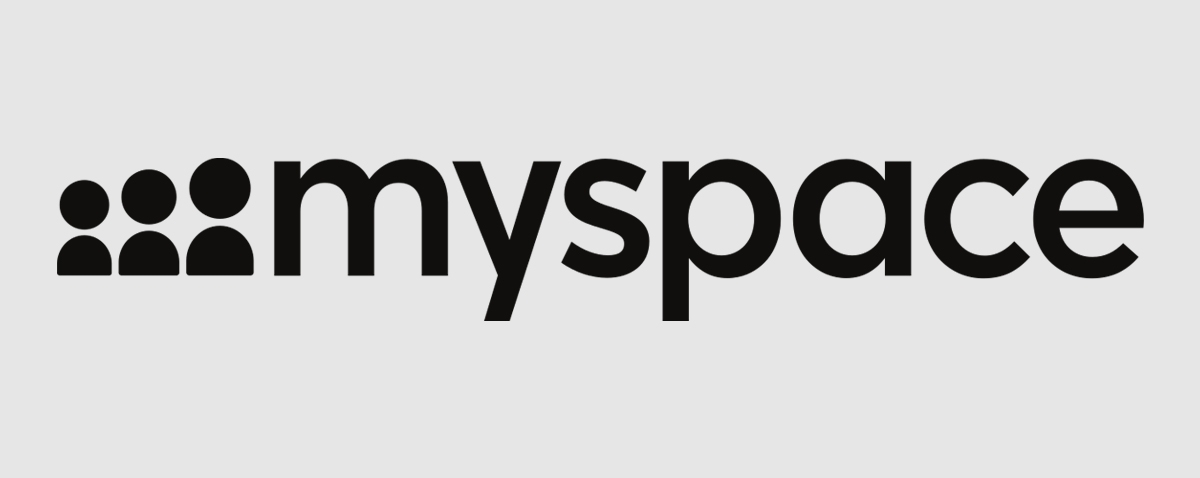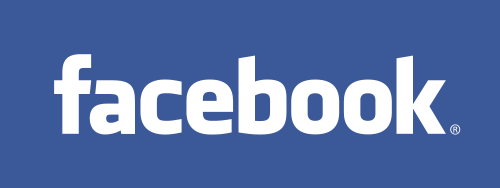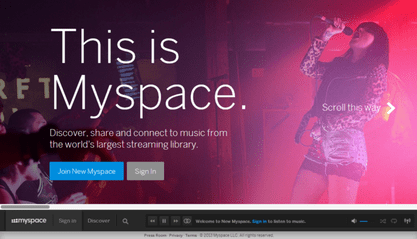Table of Contents
The rise of various social networking sites during these years allowed individuals from all over the world to establish a connection with the greater population. Apart from what is well-known today, such as Facebook, Twitter, and Instagram, people from earlier generations could experience one of the earliest social platforms available for public usage—Myspace.
During its peak era, Myspace held so much power, especially in creating more ways of connecting and communicating between people. It provided an avenue for easier communication, content sharing, and collaboration. It served as a virtual community that allowed users to interact with strangers and maintain relationships with offline friends.
However, Myspace’s rise to fame and power was not mkeant to last forever. The once hailed king of social networking sites experienced a great downfall after only a few years of being at the top. [1] Continue reading to traverse back in time and see how Myspace transitioned from being the original social networking site for the public to be the site that now only serves a specific niche.
Myspace: The Original Social Networking Site
Myspace is an online social networking site that allows users to make their profile by creating web pages where they can share different content such as their diaries, interests (e.g., music), and photographs. [2] [3] The site was created by Tom Anderson and Chris DeWolfe in 2003 when they were still employees of eUniverse (now known as Intermix Media), an Internet marketing Media. [3] Since Myspace was created for individuals to share a bit of their personal life, it helped the users maintain connections with their friends and encouraged them to establish friendships with new people. Moreover, for some people, the site paved the way for them to seek romantic relationships.
To become a member of the Myspace community, an interested user must create a profile and invite friends to be members of the community. [4] Once the user has signed up, they can search Myspace for friends who already have their accounts and add them to the network by clicking Add to friends. This inner circle, the user, has created becomes their Friend Space.
However, the network of the user was not just limited to the members in their friend space because it also included users belonging to their members’ own friend space. Put simply, the bigger the user’s friend space, the bigger the network he/she has.
In addition, Myspace Tom, who became a defining characteristic of all Myspace users and the true reason why everyone is a part of the same network as another person, could not have been forgotten by the millions of site users who have since stopped using it. Every new person who saw his profile was immediately friended. Users were able to check out which of their friends already have accounts. They were able to meet new acquaintances and establish connections as well.
The user could also have the choice of searching for other people whom they share their interests with. To explore the rest of Myspace, they needed to click the Explore link on the menu on the horizontal part of the page. Once another website pops up, the user could indicate their preferences in choosing individuals they will include in their network. There were options, such as gender, civil status, age, country, and intentions. [4]
As soon as the information as mentioned above was already selected and the Update button had been clicked, an array of potential friends was shown, and the user could start the selection process. This feature of Myspace created an avenue for users to be with the community where they can be comfortable with showing and sharing their interests. Certainly, it widened the reach of individuals even when they remain in the comfort of their own homes.
Myspace: A Complete Timeline of Events
The Rise of the King
Myspace was created in 2003; however, it was only in 2004 that it was officially launched to the public. Its features reminded users of Friendster, another social networking site that gained prominence in 2002, allowing users to create profiles, add friends, and send messages. [5] Anderson and DeWolfe intended to do so, resulting in the public referring to the former as a clone of the latter. [6] From then on, the start of the rise of Myspace became inevitable. Friendster, on the other hand, during those times, could not keep up with the increasing internet traffic—an event that surely contributed to the successes that Myspace had experienced.
After its official launch, the first two years of Myspace were a sight to behold for the founders and the management. The numbers increased from five million users in 2004 to 22 million in 2005. [7]
The Surge of Musicians and the Music Community
Moving forward, Myspace surpassed one million unique users per month in 2004, signifying how the site caught the general public’s interest. Growth was accelerated when R.E.M., one of the legendary American rock bands of all time, appeared on this thriving social networking site by posting their new album in October 2004. This did not just attract the attention of fans, but most especially, they were able to make Myspace an avenue for major music labels but most especially for indie artists, to introduce their music to a greater audience. [8] Furthermore, the site was able to cater to communities of niche kids worldwide. Although downloading entails payment from the users, Myspace offers them a chance to choose up to four songs they can freely play while staying online. [9]
Fostering a community for those with interest in music became a strategy for the company because only a few months later, in December of 2004, Myspace users were able to visit the profile of Hillary Duff, a famous pop singer, and have the chance of downloading three of her songs from a page sponsored by the marketing company of Secret Sparkle Deodorant. [7] This earned Myspace an exponential increase in its number of users because in July 2005, when News Corp bought Intermix Media Inc. This company handles the site for $580 million, and there was already a record of 22 million active members.
Although this was a win for Myspace, questions regarding the price and the decision of News Corp arose because, despite the booming popularity of their new acquisition, it was too early to say whether the success would last for long. One of the initial plans of News Corp in buying the said company was to invest in the next “big thing” in the media industry. They would also use Myspace to promote reality TV and other media content. [10]
Even in the following months, the number of new users grew. In September 2005, there were already 27 million active users—a five million increase from when News Corp took over the management. [7]
The Spread of the Samy Worm: Samy Kamkar’s Myspace Domination
Among these millions of individuals, one who stood out and caught not just the attention of the Myspace community and the media but most especially the US Federal Agents was the then 19-year-old hacker Samy Kamkar was a programmer and the co-founder of Fonality, a unified communications company that utilized open-source software as its base. [11] [12] His hacking knowledge allowed him to tweak some features the site offered. For example, he managed to upload 13 pictures to his profile instead of the original limit of 12.
However, the event that made him famous at the time was the introduction of a virus that was able to propagate over the internet and was thought to have posed long-term concerns to web security. This was done by creating a script invisible to other users, which made them release a friend request to Samy when they visited his profile.
After a few more tweaks to the system of his profile, Samy had created a virus in the form of a self-propagating worm which, to his shock, was spreading much faster than he expected. His expectations of gaining 100-200 friends over a month happened overnight. His number of friends exponentially grew from 200 to more than a million in just a day.
This resulted in Myspace shutting down to purge what they later referred to as “Samy worm.” The incident greatly challenged the whole company since they did not have a security team during that time.
The earlier incident indeed challenged the management; however, it did attract another big corporation into investing because just a year later, in August 2006, Google signed a three-year deal worth $990 million with the management to take over the ad sales for the site exclusively. [7]
The Case of Megan Meier: Myspace’s Role in the Spread of Cyberbullying
The involvement of a big corporation, such as Google, indicates that the company is on the right track. Everything seemed to fall in order for a few months until the company faced another issue.
In October 2006, a thirteen-year-old girl named Megan Meier committed suicide after she exchanged aggressive messages with a boy she met on Myspace. [13] This boy was named Josh Evans; however, he was not what you think he was.
Josh Evans was an online profile made by three of Megan’s neighbors, two of whom were a mother and daughter. The mother allegedly made the account to know what Megan had been talking about her daughter; however, during the course of events, the exchange turned hostile, resulting in Megan taking her own life.
The Meiers may not have believed it was part of the mother’s plan to push Megan to commit suicide, but they held her responsible for the insufferable consequences of her actions. [14] Myspace, in this case, provided an avenue for cyberbullying to transpire. The ease in making these accounts became a disadvantage.
The End of Reign
Given the issues surrounding Myspace, it still managed to stay on top. Just a month after Meier’s Case, Rupert Murdoch, Chairman and CEO of News Corp, stated that the then king of social networking sites was worth $6 billion and could gain 200 million unique users by 2007. [7] [15] However, a year later, in 2007, Myspace may have gained users, but it did not reach Murdoch’s target, with only 49.5 million users. [16]
In June 2008, regardless of the continued increase of the profiles registered in Myspace, its reign as the top social networking site ended. Facebook narrowly surpassed Myspace when it came to the number of users. [17] With this and the end of the three-year deal with Google, Myspace’s revenue plummeted. [18] Soon after, other social networking sites like Twitter began taking over.
To provide a summarized view of the trend of Myspace’s number of active users from 2003-2013, see the table below. [7]
| Year | Number of Active Users |
| 2003 | 0 |
| 2004 | 5 000 000 |
| 2005 | 22 000 000 |
| 2008 | 115 000 000 |
| 2011 | 60 000 000 |
| 2013 | 36 000 000 |
Source: Florian Zandt, 2021. The Rise and Fall of MySpace. Statista. Available at: https://www.statista.com/chart/26176/estimated-number-of-myspace-users-at-key-milestones/ [Accessed September 9, 2022]
The Disgraceful Downfall
What seemed to be a success for Myspace was gone only a few years after it was officially launched. In March 2009, Amit Kapur, the COO of the company, left together with two of the company’s vice presidents. [7] A month after this, Chris DeWolfe, Myspace CEO and co-founder stepped down. Not only did this change impact executives after the successful dominance of Facebook, but in June 2009, the company laid off 30% of its total employees out of a total of 1,420. The staff composing their international counterpart had also shed 300 employees from the initial 450. [7] A statement from Murdoch explained that the continuous growth of the site in the past few years became out of control and that there was a need for them to size down.
To salvage what was left of the company, Myspace purchased ILike, a social music discovery platform well-liked on both Facebook and Myspace. They also bought Imeem, a website providing fans with access to the song they were interested in, for less than $1 million to switch Imeem’s users to MySpace Music and move all their favorite playlists there. [19]
However, a year after, Owen Van Natta, the then new CEO of Myspace after DeWolfe, filed his resignation from the post. Two years after the first round of staff downsizing, another 500 workers were again laid off, resulting in a 50% decrease in the Myspace workforce. By this time, the site had already lost ten million users.
Myspace v. 2.0: Justin Timberlake’s Role in Myspace Attempted Comeback
There was only so much that the News Corp could do. Hence, the decision to sell Myspace was finalized in February 2011. The site was sold to a partnership made between Specific Media and Justin Timberlake for only $35 million, a small fraction of how much the News Corp spent in 2005. [20] This huge drop in the company’s net worth was due to the sharp decline in user count during the past months.
A year after Timberlake and Specific Media’s takeover of the company, Myspace gained one million new users, which was believed to have been due to interest in the the new music player feature.
Moreover, Justin Timberlake also exerted efforts to promote Myspace and bring it back to where it once was. His initial stint, dated September 2012, was creating a promotional video featuring a song and a promise of bringing a new and cleaner version of Myspace. It was also indicated that users could connect their Facebook and Twitter profiles which signified that there was no attempt to compete with the two. This move managed to delay the total downfall of the site.
In 2013, Myspace re-launched its mobile application; however, issues began again after users complained of not being able to access their previous accounts after the the new app launched.
Despite all these efforts, Myspace continues to lag compared to the successes that other social networking sites have had.
The Dwindling Fate of Myspace amidst Constant Management Change
Facebook had a massive 1.23 billion active users by the end of 2013, while Myspace dwindled to 36 million. [21] [7] The following years became a struggle for Myspace as it descended into an obscure fate. In 2016, Myspace again gained new management when Time Inc. acquired Specific Media, Myspace, and its parent company, Viant. In October 2017, the company noted an increasing number of site visits, only to be informed that a massive fraud scheme caused the event. [22] An announcement was made to inform the public that Myspace was not behind the fraudulent activity conducted by its partner company that increased site traffic.
In 2018 Meredith Corporation bought Time Inc., the company that handled and managed Myspace. [23] However, one year after Meredith Corporation’s purchase, it put Myspace up for sale again to unload Time Inc.’s old properties. [24]
In 2018 Myspace announced that all their user-generated content from 2015 and earlier was lost due to a failed server migration. More than 50 million songs and 12 years of content reportedly vanished entirely—an event that seemed like the last straw for the company.
For years it kept exhausting efforts to ensure that it would not get lost in the sea of technological advancements, yet here was what it ended up with. What was left of it—the amount of content that its users, both active and inactive, shared were all gone. Myspace was dying. It might be dying, but it is not dead yet.
MySpace’s Sales History from 2006 to 2010
Take a look at MySpace’s sales history and estimated operating profit history during its heyday in the social media market. [25]
| Year | Annual Sales | Estimated Operating Loss |
| 2006 | $70 million | $8 million |
| 2007 | $572 million | $48 million |
| 2008 | $1.19 billion | $34 million |
| 2009 | $1.49 billion | $229 million |
| 2010 | $1.14 billion | $431 million |
How is Myspace faring now?
A quick visit to myspace.com is proof that the site is still very much alive, but one can say that it is barely breathing when compared to the status of other social networking sites. As of 2019, 7 million users and visitors have visited the site every month. [26] It is not the site that it was before but one thing that remained the same; it continued to foster the entertainment and music community. During its heyday, Myspace targeted and used these two industries to gain more users; it is good to know that they stuck with that.
In 2022, Myspace has been slowly thriving. From being ranked 14 370th in June of the same year, its position increased to rank 13 775 in August with a total of 3.8 million visits. [29] There was also a visible increase in its social media traffic and engagement in the same month compared with records in July. Moreover, the USA remained at the top of the list of the countries that continue to visit the site. [28]
With the advent of technology, everything changes in the blink of an eye. What might have been interesting today can be the subject of ridicule the next. Once hailed as the king, or what the Gen Zs might call the OG social networking site, Myspace is now settling with the crumbs of their past successes. Although it remains functional and more accommodating to entertainment and musically inclined individuals, its name still reminds people of its glory days, far from what it is now.
References
[1] Niraj Chokshi, 2019. Myspace, Once the King of Social Networks, Lost Years of Data From Its Heyday. The New York Times. Available at: https://www.nytimes.com/2019/03/19/business/myspace-user-data.html [Accessed September 8, 2022]
[2] JavaTpoint, n.d. What is Myspace. JavaTpoint. Available at: https://www.javatpoint.com/what-is-myspace [Accessed September 8, 2022]
[3] The Editors of Encyclopaedia Britannica, 2022. Myspace. Britannica. Available at: https://www.britannica.com/topic/Myspace [Accessed September 8, 2022]
[4] Kamran Sharief, 2020. What is MySpace? – Definition, Functions, And More. Computer Tech Reviews. Available at: https://www.computertechreviews.com/definition/myspace/amp/ [Accessed September 8, 2022]
[5] Viktor, n.d. What happened to Friendster? Why did it fail? Productmint. Available at: https://productmint.com/what-happened-to-friendster/ [Accessed September 8, 2022]
[6] Nicholas Jackson & Alexis C. Madrigal, 2011. The Rise and Fall of Myspace. The Atlantic. Available at: https://www.theatlantic.com/technology/archive/2011/01/the-rise-and-fall-of-myspace/69444/ [Accessed September 8, 2022]
[7] Florian Zandt, 2021. The Rise and Fall of MySpace. Statista. Available at: https://www.statista.com/chart/26176/estimated-number-of-myspace-users-at-key-milestones/ [Accessed September 9, 2022]
[8] Billboard Staff, 2004. R.E.M. Previewing Album On MySpace. Billboard. Available at: https://www.billboard.com/music/music-news/rem-previewing-album-on-myspace-66407/ [Accessed September 8, 2022]
[9] Wikinews, 2006. MySpace to take on iTunes. Wikinews. Available at: https://en.wikinews.org/wiki/MySpace_to_take_on_iTunes [Accessed September 8, 2022]
[10] Brent Lang, 2011. News Corp.’s Failed Social Experiment: Why MySpace Didn’t Deliver. The Wrap. Available at: https://www.thewrap.com/news-corps-failed-social-experiment-why-myspace-failed-deliver-its-promise-28285/ [Accessed September 8, 2022]
[11] Lorenzo Franceschi-Bicchierai, 2015. The MySpace Worm that Changed the Internet Forever. Vice. Available at: https://www.vice.com/en/article/wnjwb4/the-myspace-worm-that-changed-the-internet-forever [Accessed September 8, 2022]
[12] DBpedia, n.d. About: Samy Kamkar. DBpedia. Available at: https://dbpedia.org/page/Samy_Kamkar [Accessed September 8, 2022]
[13] Lauren Collins, 2008. Friend Game. The New Yorker. Available at: https://www.newyorker.com/magazine/2008/01/21/friend-game [Accessed September 8, 2022]
[14] ABC News, 2009. Parents: Cyber Bullying Led to Teen’s Suicide. ABC News. Available at: https://abcnews.go.com/GMA/story?id=3882520&page=1 [Accessed September 8, 2022]
[15] Forbes, 2022. Rupert Murdoch & family. Forbes. Available at: https://www.forbes.com/profile/rupert-murdoch/?sh=1f84b2b1af66 [Accessed September 9, 2022]
[16] Tom Tsinas, 2007. Social Media By the Numbers: MySpace. Search Engine People. Available at: https://www.searchenginepeople.com/blog/social-media-by-the-numbers-myspace.html [Accessed September 9, 2022]
[17] Michael Arrington, 2008. Facebook No Longer The Second Largest Social Network. TechCrunch. Available at: https://techcrunch.com/2008/06/12/facebook-no-longer-the-second-largest-social-network/ [Accessed September 9, 2022]
[18] Viktor, n.d. What Happened To Myspace? And Why Did It Fail? Productmint. Available at: https://productmint.com/what-happened-to-myspace/ [Accessed September 9, 2022]
[19] Crunchbase, n.d. Imeem. Crunchbase. Available at: https://www.crunchbase.com/organization/imeem [Accessed September 9, 2022]
[20] Jennifer Saba, 2014. News Corp sells Myspace, ending six-year saga. Reuters. Available at: https://www.reuters.com/article/us-newscorp-myspace-idUSTRE75S6D720110629 [Accessed September 9, 2022]
[21] Ami Sedghi, 2014. Facebook: 10 years of social networking, in numbers. The Guardian. Available at: https://www.theguardian.com/news/datablog/2014/feb/04/facebook-in-numbers-statistics [Accessed September 9, 2022]
[22] Craig Silverman, 2017. Myspace Got Caught Up In A Massive Ad Fraud Scheme. BuzzFeed News. Available at: https://www.buzzfeednews.com/article/craigsilverman/remember-tom [Accessed September 9, 2022]
[23] Jessica Patterson, 2018. Here’s a timeline of Meredith’s purchase of Time Inc. and what’s been happening. FIPP. Available at: https://www.fipp.com/news/timeline-merediths-purchase-time-inc/# [Accessed September 9, 2022]
[24] Tyler Jett, 2019. Meredith Corporation sells stake in MySpace owner. Desmoines Register. Available at: https://www.desmoinesregister.com/story/news/2019/11/04/meredith-corporation-sells-equity-myspace-owner-viant/4161015002/ [Accessed September 9, 2022]
[25] Jason Wise, 2022. How Many People Still Use Myspace in 2022? (User Stats). Earthweb. Available at: https://earthweb.com/myspace-users/ [Accessed September 4, 2022]
[26] Elise Moreau, 2021. Is Myspace Dead or Does It Still Exist? Lifewire. Available at https://www.lifewire.com/is-myspace-dead-3486012 [Accessed September 9, 2022]
[27] Similarweb, n.d. myspace.com. Similarweb. Available at: https://www.similarweb.com/website/myspace.com/#geography [Accessed September 10, 2022]








